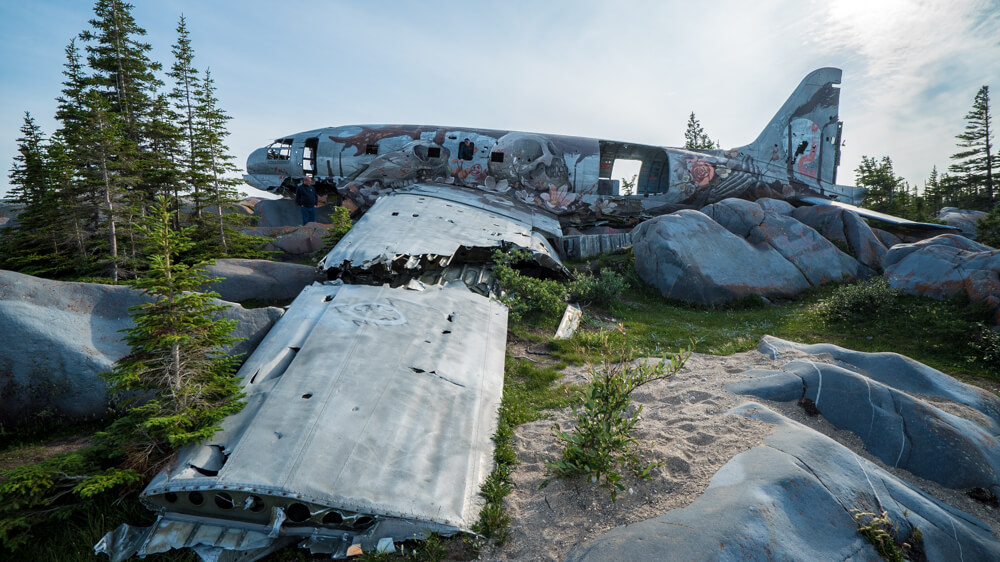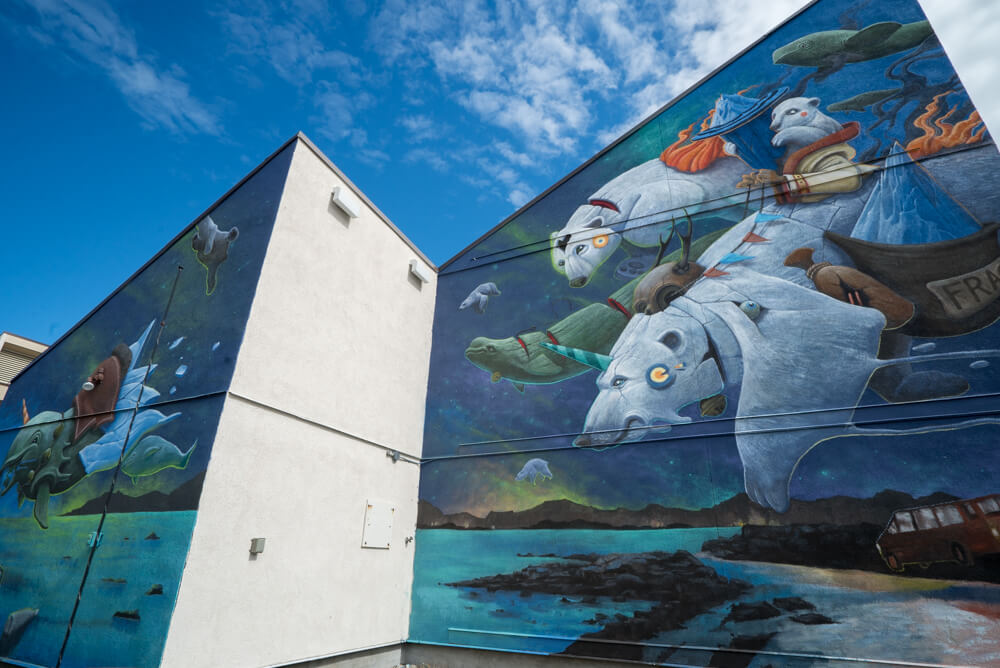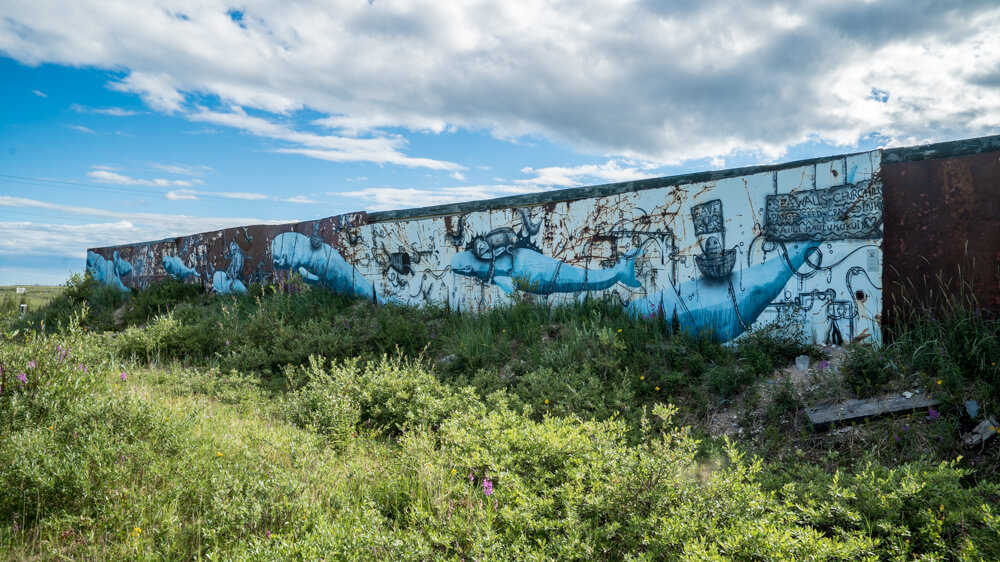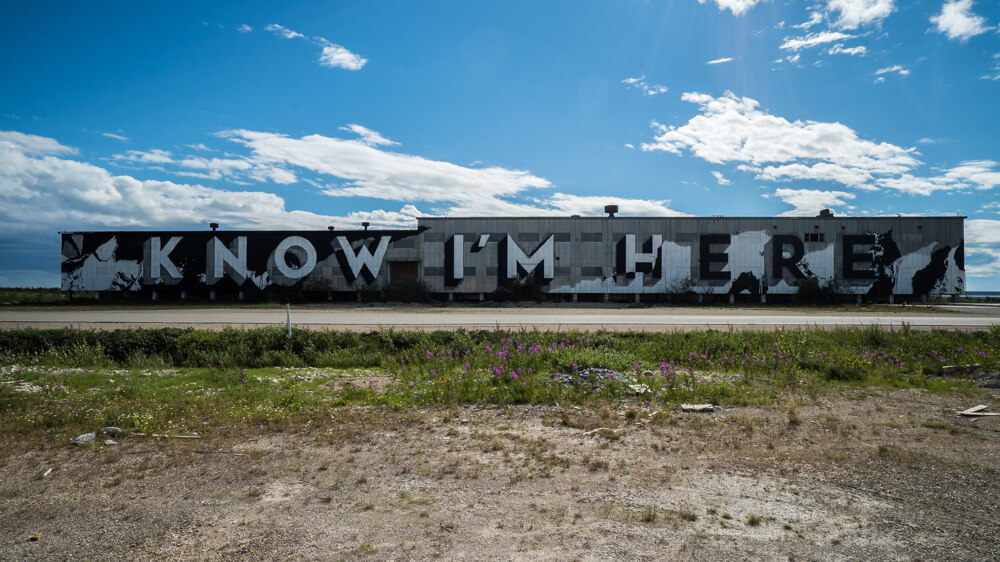
Churchill, Manitoba is known as the ‘Polar bear capital of the world’.
It’s also home to roughly 800 people who, due to recent extreme weather and flooding, have been left more or less stranded and forgotten.
Every winter, hundreds of polar bears gather and wait for the ice to form over Hudson Bay. However, due to global warming and climate change, their icy hunting grounds are shrinking rapidly, keeping the polar bears on shore longer than they should be. As a result, it has become a challenge for the polar bears to hunt seals after their summer fast.
Yikes.

Art has recently played an important role in displaying the disastrous effects of climate change in Churchill. Organized by the Pangea Seed Foundation’s Sea Walls project and Winnipeg artist, Kal Barteski, several muralists from around the world joined forces in the small town and created 18 large-scale murals that promote ocean conservation not only in Churchill, but worldwide. The paintings were completed in June of this year, leaving behind stunning murals on old buildings and giving us another reason beyond belugas, polar bears, and northern lights, to explore Churchill.
The project had its challenges. The artists had to be creative getting to Churchill due to the rail closure caused by a major flood this spring. Given there are no roads and the shipping port receives very few boats, overland transportation had to be replaced by flights, and the artists could not bring as many supplies with them as they would normally have at their disposal.
The closure of the rail has heavily impacted the locals as well, who are receiving far fewer supplies, fuel, and food than in previous years. Many also lost their jobs, and given the rail company has no plans of rebuilding, the town is suffering and feeling forgotten, left with an uncertain future.
The local residents donated whatever they could, and many were depicted in the murals as well, which feature animals, people, and the northern lights.
These are the individual messages of each of the murals:
A Small Northern Town and our Common Crisis Emergency Transmission by Pat Perry
In the artist’s words, “What I see happening in Churchill, Manitoba is frighteningly similar to what was happening in Michigan in the 1970s, 1980s, and through the present. You had the livelihoods of millions of people in Michigan tethered on life support to one industry. When that industry fled and shut down, the rest of the economy followed slowly, like a body’s delayed reaction before it realizes that the head is gone. Instead of millions of people like in Michigan, this time in Churchill there are less people, less companies, and less variables; hundreds of people, a single port that’s now closed, and a single rail line, now washed out.”
You can read the full artist statement on this mural here.
The story behind this plane wreck is interesting too: This Commando cargo aircraft was named Miss Piggy due to the size of the loads she carried. On 13 November 1979, a drop in oil pressure caused the overloaded aircraft to perform a forced landing ¼ mile short of the runway. Three crewmen were injured but all survived. Today, Miss Piggy has turned into an official tourist attraction for Churchill. This was one of my favorite murals, since you can explore the inside as well as admiring the artwork.
Power of Nature by Arlin Graff
The polar bear on this mural was reconstructed by the artist using pieces and fragments, which represent an attempt to fix what humans have destroyed in nature. “Painting them in large scale is a friendly way of asking for respect, and making people feel small when faced with the grandeur of nature.”
The Last Winter by Dulk
Dulk’s is one of the more sinister murals, showing the decay and death of the polar bears. In his words: “As a family of polar bears and begulas make their last winter journey on earth, the cub held on to its treasured iceberg, which illustrated the threat of polar bears survival due to the increased melting of the Arctic.”
Peace + Circumstance by Kal Barteski
The artist cleverly used the building’s architecture to portray a larger-than-life, peacefully sleeping polar bear. “The location of this bear, on the polar bear holding facility, highlights the intensity and necessity of wildlife management along polar bear migration paths where polar bears, the largest predators in the world, continue to adapt to the shameful realities of our consumer-driven culture.”
Of the Sea Walls festival which she organized in Churchill, she told me, “For me, the festival was exceptionally meaningful. It was important to me to show the Town of Churchill a glimpse of my gratitude. I’ve been welcomed into their community since I started visiting in 2011 and I’ve found powerful inspiration and purpose in my experiences with polar bears (and polar bear people). It was important to me to give thanks and give back. Initially, my hope was that the festival would leave the community with an opportunity to create a mural tour and generate another source of tourism income, but what we experienced while we were painting was a beautiful shift of the morale. It has been a devastating period for the small town that relies on the rail for so much of their daily life – having the artists and the energy from the festival made a remarkable change in their outlook – and ours. I am excited to see if the murals have a long-term effect. I hope to get back there to add to the collection and help the community in any way I can.”
Encounters at the End of the World by Kelsey Eliasson
According to the artist, the bears “stand as a record of Churchill as it is today, they are based on real bears that I have met over the years… As the two first bears weather and likely disappear, the ever-present beluga whales will emerge to take their place as the focal point of the piece. The third bear will also remain, as a somewhat mysterious and judgmental figure.”
Human Nature by Askew
The phrase, “Human Nature”, according to the artist, signifies a universal excuse to justify everything we are doing wrong in this world. “Churchill is a town where this is the underlying drama at all times. It’s a town so dependent on the natural environment and its wildlife and is simultaneously threatened by it too. Everything in Churchill has a duality, a total double edge to it. The text on the mural illustrates this tension and also draws from the parallels in texture of both the natural and industrial environments of the town.
Footprint by Mandy van Leeuwen
“Celebrating the resilience of the north throughout the passage of time, a place man and nature meet, where humans choose to walk together or face a great divide. As they navigate the unknown climate, government & corporate challenges that will shape their future.”
Beautiful.
Impact by Kai Kaulukukui and Crackedink
These two murals aim to send a message to fishermen to consider their waste and disposal of fishing debris.
Know I’m Here by Georgia Hill
The in-your-face mural with the phrase, “Know I’m Here,” “creates a strong message of valuing the people of Churchill, but also communicating to all people that we need to read the water and world around us in order to know our place and take actions to nurture what we have been given.”
We Swim in the Same Waters by Charlie Johnston
This mural has a dual purpose, both in memoriam of a young girl who drowned off the coast of Churchill, and the following statement from the artist: “Spirit in the water, spirit in the sky, spirit on the earth, all are connected. My piece is about ancestral legacy, what was passed on to us and what we will leave for our children’s children. She may be the Creator or Sedna the Inuit goddess of the sea. She may be Jessie Tootoo, a healer or grandmother.
Whoever she is, from her open hands the Aurora is unleashed, the ethereal cosmic voice of the ancestors speaking to us. The beluga swims through the aurora, a spirit guide legacy reminding us of what is truly valuable and worthy.”
Mile5 by Jason Botkin
This was one of my favorite murals. It reminded me so much of Teufelsberg in Berlin, though this is a tribute to the first nations people, the Dené, who like so many natives, were forced off their land. For more on the history, read on here.
Untitled by Li-Hill
In the artist’s words: “On my last day in Churchill this gorgeous wall called me. I managed to put this image up that has haunted me for years now. Calling out amid extinction, the silent roar dissolving into the fog of memory.”
Hopeful Waiting by Pat Lazo
This mural speaks to the struggle of the bears and the local residents in Churchill. The artist painted a polar bear sitting and waiting for the return of the ice, “ just as the people of Churchill await the repair of the recently damaged rail line; a vital link to their livelihood and access to essentials.”
The Rope by Case Maclaim
This painting focuses on the railway closure issue by displaying port workers struggling as tightrope dancers on the railway. “It stands as a metaphor for how fragile life can be in subarctic terrain and how essential the railway and our oceans are for the survival of the people.”
On the Brink by Li Hill
According to Li, “For my piece I have depicted two scenes, a local conservation officer from the town and a flurry of Polar bears, Arctic sleigh dogs and or wolves. Poised to shoot cracker shells, the main tool to scare off bears, the uniform and stance of the officer allude to times of hunting and stand for human aggression |…| In the context of the town and specifically the recycling center where this mural was painted, the interaction between bears and conservation officers are extremely common and the reading of this piece becomes more specific.
In the broader context and more central to theme is the fact the image radiates outward from a division line. Instead of man vs nature here, it is two sides of the same coin. Both humans and endangered species are in a state of fight or flight. A heightened sense of emergency due to climate change and the long list of global issues place everything in a precarious position. In a town such as Churchill the tensions are local but the story is global.”
Pump by Takashi Iwasaki
This lone building is located across from “Know I’m Here” and for a brief period each summer, is framed by this beautiful purple flower, fire weed.
According to the artist, “my artwork addresses the circulation of water in the world in connection to the Pump House on which my mural is painted. The water travels from the Pump House to the faucet, to the people, back to the ocean, plants, and back to the Pump House again. We are all connected and depend on the health of our water supplies and sources to survive. Simply put, water is life.”
The Final Destination by Stormy Angeconeb
This mural is a tribute to the many seabirds in and around Churchill.
The murals are located in various spots all along the Hudson Bay. In a few hours, it’s possible to drive around and visit all of them (here’s a map), all while enjoying the landscape and scouting polar bears as well.
My thoughts are with the town of Churchill, and especially the polar bears and belugas who made an appearance during my time there in July. Climate change is a subject I’m passionate about and I hope that the story of these murals and the message they intend to send reaches more people in Canada and beyond.
Because, at least for now, Planet Earth is the only home we have.


















Izy Berry says
This is so sad. No port, declining commerce plus climate change affecting the polar bears and beluga whales… It’s amazing how art can send powerful messages across, I hope people of authority hear them and be moved to act!
GG says
Thanks for telling this incredible story about Churchill and the artists and climate change. So well done. This could be in National Geographic. Such beautiful artwork with limited resources rivaling any artwork in the world and telling such a narrative. The whole issue with the railroad is a shame and hopefully it can be back up and running before winter even with the propane shipped to them.
The good news is while they claim melting permafrost and extreme weather is hurting the ability of the rail line to function, it really is more about properly maintaining the rail road and putting in the money to do so, than trying the patch and fix it approach. This applies to all transportation infrastructure, both in Canada and the U.S., maintenance is paramount, let that go and you will pay multiple times later and you will have old, failing bridges (remember Minneapolis?).
Churchill used to have a population of 5000 or so and now is down to 800-900. One could argue that it isn’t worth the expense to keep a community like this going, but as you can see from this post, are you kidding me? What I am excited about is how the tribal community is trying to see if they can purchase the railroad and maintain it using their intimate knowledge of the terrain and the fact that they actually care about it. Sometimes you just have to take things into you own hands, although I don’t see the bigger cities not taking handouts like crazy :). If the area could find a way to handle all of its core functions without dependence on for-profit rail roads or industries with no personal interest in the area, that would be ideal (need the government there but as assistance not dependence). I guess this touches me because this issue of northern communities also has been dealt with to me insensitively in other areas of the world like the small tribal communities in Alaska.
This rail line benefits not only Churchill, but all the communities in the region and bigger does not mean better.
I hope that people like you, Kristin, can bring this story to more prominence, especially among those who would want to tour the place for its majestic wonders. I read an article claiming Churchill was like Detroit, a city left behind. I disagree, Churchill is more like Pittsburgh, an old steel town that adapted and reinvented itself, to become a thriving city. Not to say you don’t want the other extreme of a lot development.
Instead of banks and technology for Pittsburgh, Churchill has such natural wonders and history that can complement the waning industrial and scientific research conducted there. More polar bears congregate there than anyplace in the world (pretty much) and where can you swim with belugas and observe polar bears on the same day!? Weather enthusiasts would enjoy the extremes experienced there. Oh and I forgot about the cool military fort, Eskimo museum, a former rocket range, and of course Ms. Piggy. Then there is the warmth of the people. The kids are cute and you interacted so awesomely with them, like a favorite aunt.
As for the climate change angle, what is neat to see is how much is starting to get done at the grass roots levels where things really get done. It is no coincidence so many of the strongest pushes for carbon neutrality are the big coastal cities, no matter the politics of the state they are in. So many mayors have signed on in the U.S. While any impacts are still in the noise in the lower latitudes people don’t realize how much change is already occurring in the high latitudes! Art is a great way to convey the anxiety, concern and observations concerning the change being witnessed up there in addition to the concrete story.
Stuart Forster says
Churchill is one the most remarkable places I’ve visited. I loved reading about the artworks on walls in the remote town.